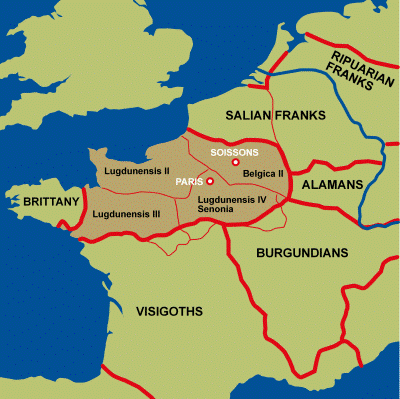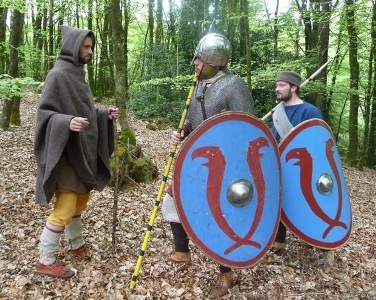Guest post by Justin Swanton, author of Centurion's Daughter
 Today I'm pleased to welcome Justin Swanton, a South Africa-based novelist and illustrator, who has contributed a detail-rich essay about the twilight of Roman Gaul and the corresponding rise of the Franks under Clovis in the late 5th century. In his novel Centurion's Daughter, Aemilia, a young woman of seventeen, gets caught up in the war between the last unconquered Roman provinces and the Frankish alliance. How do you research a period that's historically important but in which the primary sources are maddeningly few? Below, Justin explains his process and the conclusions he drew from what he learned.
Today I'm pleased to welcome Justin Swanton, a South Africa-based novelist and illustrator, who has contributed a detail-rich essay about the twilight of Roman Gaul and the corresponding rise of the Franks under Clovis in the late 5th century. In his novel Centurion's Daughter, Aemilia, a young woman of seventeen, gets caught up in the war between the last unconquered Roman provinces and the Frankish alliance. How do you research a period that's historically important but in which the primary sources are maddeningly few? Below, Justin explains his process and the conclusions he drew from what he learned.~
Centurion’s Daughter is set in an era that has hardly been touched by fiction: Gaul at the end of the fifth century, when the last provinces of the Western Roman Empire were attacked by a Frankish confederation under Clovis. It is a fascinating period and an important one, as everything that happened here would determine the nature of the Middle Ages that followed.
Besides the history, you would think the personages and events would bring novelists out in droves. On one side you have Afranius Syagrius, 57, Roman aristocrat and general, epitomizing everything the old order had stood for. On the other side there is Clovis, 20, young and dynamic, who would acquire a Catholic wife he deeply respected and, later on, her religion, making him so much the future of western Europe. Clovis was a man to take incredible risks when necessary. At the Battle of Vouille he confronted a vastly superior Visigothic cavalry. What other general would have gathered his personal guards, charged straight at the Visigothic king Alaric, killed him personally in hand-to-hand combat, then galloped back to his lines with the entire enemy cavalry in hot pursuit? Riveting stuff.
So why is the period almost untouched? The problem as I found out is the research. Just things like discovering that Syagrius’s first name was Afranius was quite an achievement. Putting together a coherent picture of the time took me years and involved a careful reading of the primary sources, as well as abandoning several popular misconceptions. Let me give a few details of what I uncovered.
1. The Roman army survived the official fall of Rome. Procopius, personal secretary to the Byzantine General Belisarius, describes as something remarkable the fact that formations of the Western Imperial army had endured right up to his time, the middle of the sixth century, with their standards, uniforms and traditions intact. These were the units – former legions – that Syagrius had led with confidence against Clovis. After Syagrius fell, they were maintained by rich Roman aristocrats as bucellarii, or private troops.
 Credit: Letavia2. The Roman nobility also survived the official fall of Rome. A popular conception of the fall of the Empire consists of hordes of barbarians marauding over the countryside, pillaging and burning, ending the Roman way of life forever. The truth was very different. In places like Britain, parts of Spain and north Africa, society did descend into anarchy, but this came more from internal dissolution than barbarian influence. The greater part of the former Roman territories, however, kept their societal structures intact, which meant the wealthy landed class – rich senators – remained in possession of their estates, even under barbarian rule. It is a complicated period. The new barbarian masters worked with the entrenched Roman ruling class, they did not displace it.
Credit: Letavia2. The Roman nobility also survived the official fall of Rome. A popular conception of the fall of the Empire consists of hordes of barbarians marauding over the countryside, pillaging and burning, ending the Roman way of life forever. The truth was very different. In places like Britain, parts of Spain and north Africa, society did descend into anarchy, but this came more from internal dissolution than barbarian influence. The greater part of the former Roman territories, however, kept their societal structures intact, which meant the wealthy landed class – rich senators – remained in possession of their estates, even under barbarian rule. It is a complicated period. The new barbarian masters worked with the entrenched Roman ruling class, they did not displace it. 3. It took Clovis ten years to conquer the last Roman provinces. This is my own conclusion, after comparing primary sources like Gregory of Tours, Procopius, the Life of St Genovefa, the Liber Historiae Francorum, and other works. To sum up the history, Clovis was a foederatus, or subordinate ally of Syagrius, who initially gave him the title to Belgica II, one of the four provinces he controlled. Time passed and Syagrius decided to reassert his authority over the province, setting up his capital in Soissons. In 486 Clovis gathered an alliance of Salian Franks and fought Syagrius near Soissons, defeating him. The Roman governor was deposed by his realm and forced to flee to the Visigoths, who later handed him over to Clovis for execution. The three Roman provinces not under Clovis’s control made their stand and stopped the Frankish king dead in his tracks for ten years. It was during this time that Paris was besieged and, under the leadership of St Genevieve, successfully held out against the Franks.

In 493 Clovis married St. Clotilde, a Burgundian princess whose father and mother had been murdered by her uncle. She was a Catholic and immediately set out to convert her pagan husband, partly because it was the only way to end the war between the Franks and Gallo-Romans, who would never accept a pagan ruler. Clovis loved her and allowed her to baptize their children, but only became Catholic himself when his army was on the brink of rout in a battle against the Alamans in 496. He promised the God of Clotilde he would convert if he won. The Franks rallied and went on to victory, and Clovis kept his word and was baptized on Christmas Eve that year or the year following. With Clovis a Catholic a peace could finally be brokered and the last provinces of Roman came under Frankish rule, with the exception of Brittany which remained semi-independent.
 Credit: LetaviaMy own novel covers the time just before, during and after the battle near Soissons between Syagrius and Clovis. Personally I like sticking to the old Greek drama rule of having everything happen in one place during a limited period of time. Centurion’s Daughter takes place in or near Soissons over the space of a year.
Credit: LetaviaMy own novel covers the time just before, during and after the battle near Soissons between Syagrius and Clovis. Personally I like sticking to the old Greek drama rule of having everything happen in one place during a limited period of time. Centurion’s Daughter takes place in or near Soissons over the space of a year. A lot of time went into researching Gallo-Roman daily life at the end of the fifth century. Again, it wasn’t easy. I couldn’t find a book that covered clothing, eating habits, furniture and housing arrangements of Gallo-Romans at the very end of the Empire, all under one cover. It was very much a case of uncovering a bit here and a bit there. Gallo-Romans, for example, had wickerwork high-backed chairs and usually ate at tables, not lying on couches like the Romans of Italy. Money was really problematic. I didn’t have too much difficulty finding out what coins were in use, but deducing to what extent the monetary system had collapsed and been replaced by barter was much less straightforward. Coin and barter both exist in my novel. In the end I had to use educated guesswork for a number of the details.
Now that the research is substantially done I intend to use it for a number of future novels of which one is already in the pipeline, taking place near the end of the ten-year war described above. It is an exciting era, and I don’t regret the effort I put into it. I hope you enjoy the result.
~
Justin Swanton is a graphic designer and manager in a small printing firm in South Africa. Centurion’s Daughter is his first novel. He has a website and a blog. Besides writing, his interests are computer and hand drawn illustration and wargaming.
Centurion's Daughter was published by Arx in 2011 (list price $17.95, heavily discounted on Amazon; trade pb; 336pp). The Kindle edition sells for $5.97.
Published on March 03, 2013 22:00
No comments have been added yet.



